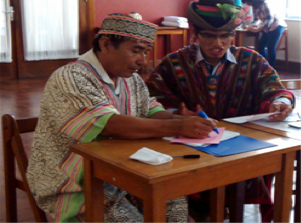“It is worth dreaming of,” were the thoughts of the Palotes of Quechua, Aymara and Shipibo indigenous groups and members of a network of Indigenous Youth. They had experienced and suffered discrimination for speaking, dressing, dancing, singing or eating differently. In one of the last meetings of the network, they had expressed, “Our vision, conviction and commitment, is to contribute to build a society that respects diversities, in which indigenous youth, as part of our peoples, fully exercise our collective and individual rights.” They added that as a network, they aim to contribute to the country’s consciousness where the affirmation of one’s identity, self-determination, mutual respect without discrimination and the recognition of cultural diversity are the fundamental bases of the Peruvian nation.”
The Palotes, Costantino and Giraida approached a group of elders who are knowledge holders, and they agreed to organize a dialogue and exchange on ancestral knowledge. The participants made a great journey travelling through the Amazon jungle and the great mountains in the Andes and finally arrived in Lima, where they held knowedge exchange activities. They wished to share their cultural heritage with the rest of the world.

The young participants with their many questions lined up to wait for their turn. The first question was: “Why are we in the city if culture, wealth and knowledge are in our villages? But the answer of the wise elders of the communities was, “The world is changing at the speed of light, and in my dreams, I see new things; many brothers and sisters travelling to the city. So now, it is important to learn to relate to the city, technology, and exchange the learning of these new experiences with the knowledge of our people.”
The exchange began with a very basic meaningful activity where each participant declared their indigenous nation and community of origin. They were also asked to identify an animal that they felt represented them within their community and explain their choice.

They were then asked to draw the animal and paste it onto the depiction of the “Tree of Life,” a cultural tradition in the Amazon. They drew domestic animals, various kinds of birds of different colors and sizes, the lion and the great ant. They explained, “Wild animals are related to our lives, with our Pacha Mama or Mother Earth.” We selected them for “their strength, their astuteness, and their sense of belonging to the community.” As the hours passed, the stories of the wise elders were woven together, with the memories that each young participant kept in their mind and heart. These were offered at the end as a beautiful tapestry adorned with commitments to care, to prevent the disappearance of indigenous knowledge of their communities , because they are the strength of their peoples and the base on which they should continue building a country that respects diversities.

The journey of this group of young activists to discover their cultural traditions, through dialogue and exchange with the wise elders of their communities also served to recover oral stories and traditions about spirituality and sacred sites. One of the stories shared was “The Legend of Cumancay,” a tradition of the Shipiboof the Ucayali River. The story is about the arrival of the Spanish invaders to the territory of Cumancay, named after the tree that is known in Spanish as Shihuahuaco. The invaders brought disease and slavery to the village where the Ani Sheati, a community festival, was traditionally celebrated. The story concludes with how a wise shaman found the magical powers of the Cumancay tree to recover the good life in the village.”
Through stories, the group of boys and girls learned about the relationship of indigenous peoples with their territories, spirituality and worldview. The grandparents were delighted and proud to learn that their knowledge was helping the youth to strengthen their identity and cultural roots. The young participantsdeclared, “We strengthened our indigenous identity, we felt more indigenous.” Everyday, the meetings ended with a ceremony where they expressed their gratitude for the ancestor’s presence and harmonized energies among the participants.
The process of exchange of knowledge among young people and indigenous elders was facilitated by CHIRAPAQ, the Network of Indigenous Youth of Peru in Lima, Peru. It was supported by the Pawanka Fund. (you can listen to the story by clicking on this link:www.pawankafund.org Narrated by Andrés González Torres, Ketín González Torres and Andrés González Pérez).
